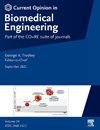细胞外基质-黏附界面的纳米力学
IF 4.2
3区 工程技术
Q2 ENGINEERING, BIOMEDICAL
引用次数: 0
摘要
细胞外基质(extracellular matrix, ECM)的力学特性在调节细胞迁移、发育和增殖等基本过程中起着至关重要的作用。细胞在ECM上产生拉力,同时,局灶性粘连体会到来自ECM的机械信号。然而,使细胞感知和适应其机械环境的分子机制仍然知之甚少。细胞内和细胞外张力传感器的进步已经能够量化生理上相关的作用力,这些作用力触发了相关蛋白质的构象变化,这些变化可以用体外单分子技术进行跟踪。从早期的AFM实验集中在僵硬的ECM蛋白,如腱蛋白和纤维连接蛋白,到最近的磁镊子研究机械不稳定的黏着蛋白,如talin和vinculin,我们正在逐步阐明力传感过程的物理化学原理。在这篇综述中,我们讨论了ECM和黏附蛋白的纳米力学研究的最新进展,重点介绍了分子尺度力学如何在细胞水平上驱动复杂的机械传感和机械转导过程。本文章由计算机程序翻译,如有差异,请以英文原文为准。
Nanomechanics at the extracellular matrix-focal adhesion interface
The mechanical properties of the extracellular matrix (ECM) play a crucial role in regulating fundamental cellular processes, including migration, development, and proliferation. Cells generate pulling forces on the ECM, while simultaneously, focal adhesions experience the mechanical cues transmitted from the ECM. However, the molecular mechanisms that enable cells to sense and adapt to their mechanical environment remain poorly understood. Advances in intracellular and extracellular tension sensors have enabled the quantification of the physiologically relevant forces at play, which trigger conformational changes in the involved proteins that can be tracked with single-molecule in vitro techniques. From early AFM experiments focused on stiff ECM proteins like tenascin and fibronectin to recent magnetic tweezers studies of mechanically labile focal adhesion proteins, such as talin and vinculin, we are progressively elucidating the physicochemical principles underlying force-sensing processes. In this review, we discuss recent advances in the study of the nanomechanics of ECM and focal adhesion proteins, highlighting how molecular-scale mechanics drive complex mechanosensing and mechanotransduction processes at the cellular level.
求助全文
通过发布文献求助,成功后即可免费获取论文全文。
去求助
来源期刊

Current Opinion in Biomedical Engineering
Medicine-Medicine (miscellaneous)
CiteScore
8.60
自引率
2.60%
发文量
59
 求助内容:
求助内容: 应助结果提醒方式:
应助结果提醒方式:


